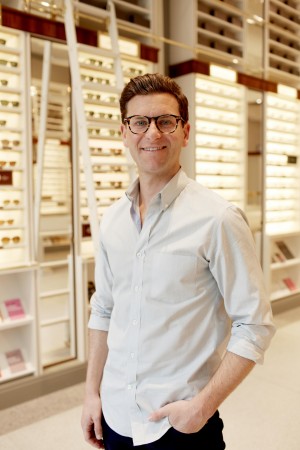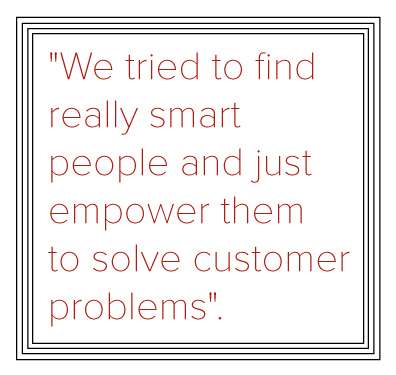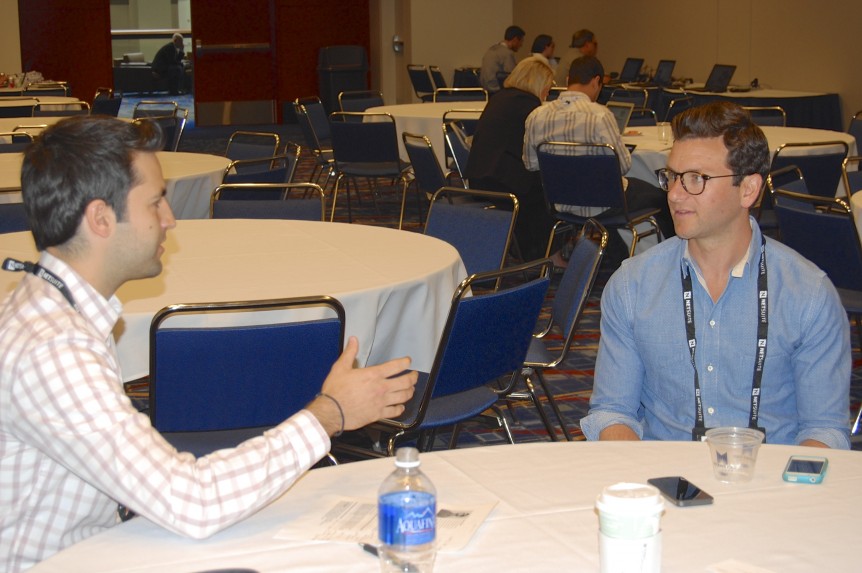In part one of a three-part exclusive, Warby Parker Co-Founder and Co-CEO Dave Gilboa shares his tips for building an online brand using offline tactics.
 Forefront Publisher George Bozonelos had the opportunity to interview Dave Gilboa, Co-Founder and Co-CEO of Warby Parker at the IRCE conference in June (read our post about the conference here). The two covered a range of topics throughout the conversation, and we wanted to share as much as possible with you, our readers.
Forefront Publisher George Bozonelos had the opportunity to interview Dave Gilboa, Co-Founder and Co-CEO of Warby Parker at the IRCE conference in June (read our post about the conference here). The two covered a range of topics throughout the conversation, and we wanted to share as much as possible with you, our readers.
Our blog features parts one and two of the series, and part three will be published in the next edition of Forefront magazine (available Sept. 6, 2013). In the dialogue, Gilboa offers interesting perspective on building up an Internet retail business and on the dynamic of a Co-CEO relationship.
Part 1: How to Sell a Physical Product in a Virtual World
Part 2: Are Two CEOs Better Than One?
Conventional wisdom says friends make terrible business partners. In part two, Gilboa shares how it worked in Warby Parker’s favor.
Part 3: What Millennial Workers Want
Gilboa reveals how Warby Parker attracts and retains top Millennial talent.
George Bozonelos: To set the stage, what are some of the recent milestones of Warby Parker?
Dave Gilboa: We launched the company just over three year ago, in February 2010. Three friends and I started it from our apartments while we were in school. Now we’re 250 employees, all based in New York, and growing much faster than we ever expected.
We launched the brand thinking 100 percent of our business would be online. But we quickly found that some customers wanted to engage with both our products and our team in an offline environment. Over the past three years, we have tried various iterations of offering physical locations for our customers to shop at in addition to our online presence. These include showrooms inside our office in NYC and existing boutiques throughout the country, pop-up shops and the Warby Parker Class Trip—a yellow school bus that we converted into a mobile store.

There are a couple of exciting things that we’ve launched over the last few months. We launched our first permanent bricks and mortar store. It is a beautiful space in SoHo on Prince and Green, across the street from the Apple Store, next to Ralph Lauren. That launched a few weeks ago. It’s been a massive success. We’re pretty excited about the opportunity to offer a great online experience and a great offline experience.
I think there’s a growing trend where companies are realizing that consumers are not going to do all their shopping online and they’re not going to do it all offline, so if you want to be a great brand or great retailer—one that is really focused on great customer service—you need to be where your customers are and have to figure out a way to have a presence in both channels.
Bozonelos: This touches on another question we have, in the spirit of the IRCE Conference. Your team clearly saw some of the benefits of being only online, but now you are exploring brick and mortar. What are the challenges you face in both respects?
Gilboa: We’ve realized that there are a lot of consumers who prefer to shop online. They find it really convenient to be able to just log on, in a self-serve environment, and order online. There’s also a segment of population that feels more comfortable walking into stores. Right now, about 99 percent of glasses are still sold in the offline world, but over time that’s going to shift. Ninety-nine point nine percent of our first-time customers have never bought glasses online. We can provide an environment that they’re more comfortable with, build that trust and engagement, then the next time they’re buying glasses they’re going to feel more comfortable just going online since we’ve already built that trust. We’ve proven that we can deliver a high-quality product and great service. We’re finding that 90-plus percent of our customers that are walking into our stores and showrooms are first-time customers, but then the vast majority of repeat customers are ordering online.
I think there are a ton of benefits of selling products online, but there are also some major challenges—particularly when selling products that people want to try on and touch and feel.
We’ve looked for opportunities in our online shopping experience to allow people to try on our glasses and touch and feel the product. We have a virtual try-on using some pretty cool facial recognition technology, where you can take a photo of yourself and virtually put the glasses on your face. This is a really popular feature, but we also wanted to give people the opportunity to touch and feel our actual product—we know we have an incredibly high-quality product and want to get our glasses on as many people’s faces as possible. So we introduced our Home Try-On, where customers can select any five frames from our website and we’ll ship them to a customer’s home for free and include a free return shipping label. It really comes down to building trust and giving the customer confidence that they’re buying a high-quality product that is going to make them look good.
Another challenge is that as consumer-friendly as you can make a website, it doesn’t touch all five senses. So having a physical manifestation of our brand in the form of a store that someone can walk into allows customers to touch and feel every element of the brand. They can meet our employees, who are themselves representatives of the brand, and can help them with any questions in real time. I think that’s really hard to replicate purely online.
Bozonelos: You mentioned customer service a few times, and I know you are speaking at the conference regarding using Twitter for customer service. As an online retailer, how do you tackle that customer service aspect, especially with the virtual product?
Gilboa: We recognized that it is a huge hurdle for most consumers who have never bought glasses online, have never seen our brand before, to take that leap of faith and buy product online. We really tried to de-risk the purchase process as much as possible.
We offer free shipping and free returns on every order, even our prescription glasses. We offer free virtual try-on and a free home try-on, where people can select five frames and try them on their home. We include free return shipping labels. People send them back with no obligation to purchase.
Then we really invest in our customer service teams. We’ve been able to attract some really talented people from top universities and hired people from investment banks and top consulting firms that otherwise would never be found in a call center environment.
We really view customer service as a core marketing channel for us. We tried to find really smart people and just empower them to solve customer problems.
I think that it’s kind of crazy for most companies to think of customer service as a cost center that should be minimized and try to be the lowest cost area—people pay the least and try to get customers off the phone as quickly as possible. We don’t think that’s the right way to build a brand and a business, so we continue to invest more money into customer service and think that’s the way just to build trust.
Check back in on 9/6 for part two of the interview with Gilboa.
Dave Gilboa is the co-CEO of Warby Parker. Read his bio here.



